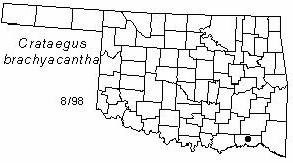Shrub or small tree to 6 m (18 ft) in height and up to 15 cm (6 in) in diameter. Crown broad, but irregular and open. Inner bark reddish-brown. Outer bark gray and flaking. Twigs reddish brown to gray, glabrous, short, with curved spines approximately 2 cm (0.8 in) long. Leaves alternate, simple, elliptical, 2.5-5 cm (1-2 in) long and 13-25 cm (0.5-1 in) wide, glabrous above, glabrous to pubescent below, dark green above, paler below, narrow at base, blunt or rounded at apex, wavy, saw-toothed and rounded with gland-tipped teeth. Flowers in corymbs, glaborous, numerous, 8 mm (0.3 in) diameter; calyx tube obconic, glabrous, and 5-lobed; petals 5, white, fading to orange with age; styles 3-5; stamens 10-20, anther pale yellow; flowers appear March to April. Fruits pomes, 10-13 mm (0.4-0.5 in) in diameter, globose, bright blue to black, with 3-5 nutlets, maturing in August.
Distribution: Coastal plain of of Georgia, west to Arkansas and east Texas and Oklahoma. Rare in Oklahoma; restricted to Coastal Plain physiographic province.
Habitat: floodplains, swamps and lowlying areas.
Comments: Crataegus is from the Greek meaning "flowering thorn"; brachyacantha refers to the short spines.
Field identification: the blue fruits and short curved spines readily distinguish blue hawthorn from other species of hawthorn. However, if fruits are not present, blue haw can easily be confused with little-hip hawthorn (C. spathulata). The leaves are very similar. The leaf veins of blue haw extend from the midrib to the lobes and sinuses; veins of little-hip hawthorn extend only to the lobes. Identification is much easier when fruits are present; blue haw has dark blue fruits, the fruits of little-hip hawthorn are bright red.
Wildlife benefits: In general, the fruits of hawthorn species are eaten by several species of birds. The dense branching patterns supply shelter.
NWI status: FACW, OBL.
Distribution in Oklahoma: 
BACK
NEXT
RETURN TO INDEX
Last update: 9/9/99
 Go to Oklahoma Biological Survey Home Page
Go to Oklahoma Biological Survey Home Page
 Disclaimer
Disclaimer